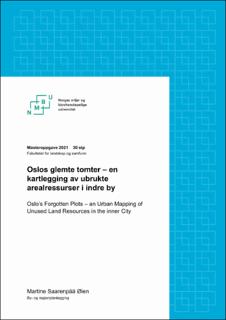| dc.contributor.advisor | Elin Børrud | |
| dc.contributor.advisor | Eirik Nilsson Gundersen | |
| dc.contributor.author | Øien, Martine Saarenpää | |
| dc.date.accessioned | 2022-04-08T16:27:11Z | |
| dc.date.issued | 2021 | |
| dc.identifier | no.nmbu:wiseflow:6444327:47498260 | |
| dc.identifier.uri | https://hdl.handle.net/11250/2990808 | |
| dc.description.abstract | Nåtidens praksis innenfor byutvikling er at ny bebyggelse plasseres innenfor etablerte tettstedsgrenser. I Oslo representerer Markagrensen bebyggelsens sluttpunkt. For å kunne bevare Markagrensen, må arealene innenfor byggesonen utnyttes så effektivt som mulig for å kunne imøtekomme den forventede befolkningsveksten. Oslo kommune har av den grunn ført en fortettingspolitikk som legger vekt på en fortetting innenfra og ut med et mål om å bli en kompakt by. Denne oppgaven er et bidrag til å øke bevisstheten rundt hvordan arealene i Oslos indre byggesone utnyttes. Formålet med oppgaven har vært å avdekke om det finnes en uutnyttet arealreserve, hva som karaktereiserer arealene, hva som hindrer en eventuell utbygging av disse arealene, og hvordan arealene kan tilføre kompakte bykvaliteter.
Del en av oppgaven er løst med bruk av kartlegging som kvantitativ metode. Gjennom kartleggingen er ledige arealer og arealer som kan få en høyere utnyttelse, blitt kartfestet og kategorisert i et datasett som har gitt ny kunnskap om arealbruken i Oslos mest sentrale områder. Informasjon fra datasettet har blitt analysert med sikte på å finne ut om arealene kan være en ressurs, og hvorvidt det bør settes inn tiltak for å utnytte de. Del to av oppgaven er løst gjennom kvalitativ metode hvor funn fra analysedelen drøftes gjennom et teoretisk perspektiv om mulighetsrommet til eiendomsutvikling. Dette mulighetsrommet består av tre vegger; regulering, tomt og marked, hvorav ulike krefter og motkrefter utspiller seg i ulik grad etter arealkategoriene.
Studiet har vist at det eksisterer et mangfold av ledige arealer. Det er infill, sloap, veiareal og feltutbygde blokkområder som utgjør den største ressursen. Arealkategoriene påvirkes ulikt av de tre veggene i mulighetsrommet. Varierende karaktertrekk ved arealene gjør at de vil kunne oppfylle forskjellige behov av bykvaliteter, og at det er ulike årsaker som hindrer at de blir utviklet. Infill og sloap kan tilføre byen kompakte bykvaliteter i form av en økt demografisk og funksjonell tetthet, men disse arealene har også mulighet til å veve sammen byens strukturer. Utviklingen av disse arealene hindres i stor grad av mangel på aktører som har byutvikling og ikke profitt som fokus og mål. Veiarealer og feltutbygde blokkområder har i kraft av tomtenes egenskaper en økt mulighet til å bebygges med større og varierte strukturer med flere funksjoner. Det vil være tomtestrukturen og reguleringsrisikoen som er de viktigste årsakene til at veiarealene ikke er utviklet. Feltutbygde blokkområder har et stort mulighetsrom, og få hinder, men eierstrukturen leder til at det disse er vanskelig å utnytte. | |
| dc.description.abstract | Current practice in urban development is that new buildings are placed within established urban boundaries. In Oslo, Markagrensen represents the end point of the settlement. In order to preserve Markagrensen, the areas within the construction zone must be utilized as efficiently as possible in order to be able to meet the expected population growth. For this reason, the City of Oslo has pursued a densification policy that emphasizes densification from the inside out with a goal of becoming a compact city. This thesis is a contribution to raising awareness of how the areas in Oslo's inner building zone are utilized. The purpose of the thesis has been to uncover whether there is an unused area reserve, what characterizes the areas, what prevents a possible development of these areas, and how the areas can add compact urban qualities.
Part one of the assignment is solved with the use of urban mapping as a quantitative method. Through the urban mapping, vacant areas and areas that can have a higher utilization have been mapped and categorized in a data set that has provided new knowledge about land use in Oslo's most central areas. Information from the data set has been analyzed with a view to finding out whether the areas can be a resource, and whether measures should be put in place to utilize them. Part two of the thesis is solved through a qualitative method where findings from the analysis part are discussed through a theoretical perspective on the opportunity space for real estate development. This opportunity space consists of three walls; regulation, plot and market, of which different forces and counter-forces take place to varying degrees according to the area categories.
The study has shown that there is a diversity of vacant areas. It is infill, sloap, road areas and field-developed block areas that constitute the largest resource. The area categories are affected differently by the three walls in the opportunity space. Varying characteristics of the areas mean that they will be able to meet different needs for urban qualities, and that there are various reasons that prevent them from being developed. Infill and sloap can add compact city qualities to the city in the form of an increased demographic and functional density, but these areas also have the opportunity to weave together the city's structures. The development of these areas is largely hindered by a lack of actors who have urban development, and not profit, as their main goal. Due to the characteristics of the plots, road areas and field-developed block areas have an increased opportunity to be developed with larger and varied structures with several functions. It will be the plot structure and the regulatory risk that are the most important reasons why the
road areas have not been developed. Field-developed block areas have a large opportunity space, and few obstacles, but the ownership structure means that these are difficult to utilize. | |
| dc.language | nob | |
| dc.publisher | Norwegian University of Life Sciences | |
| dc.title | Oslos glemte tomter – en kartlegging av ubrukte arealressurser i indre by | |
| dc.type | Master thesis | |

